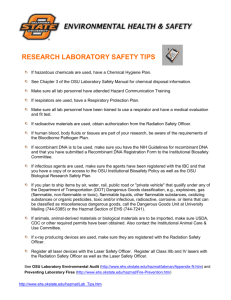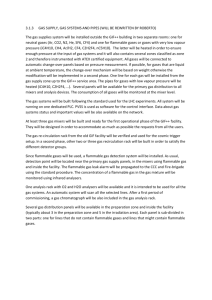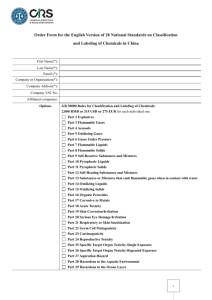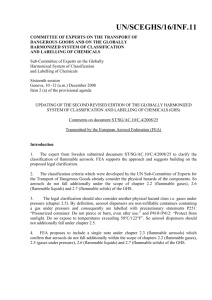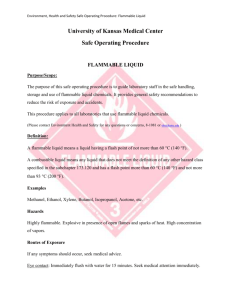Safety Training Classes - Oklahoma State University
advertisement
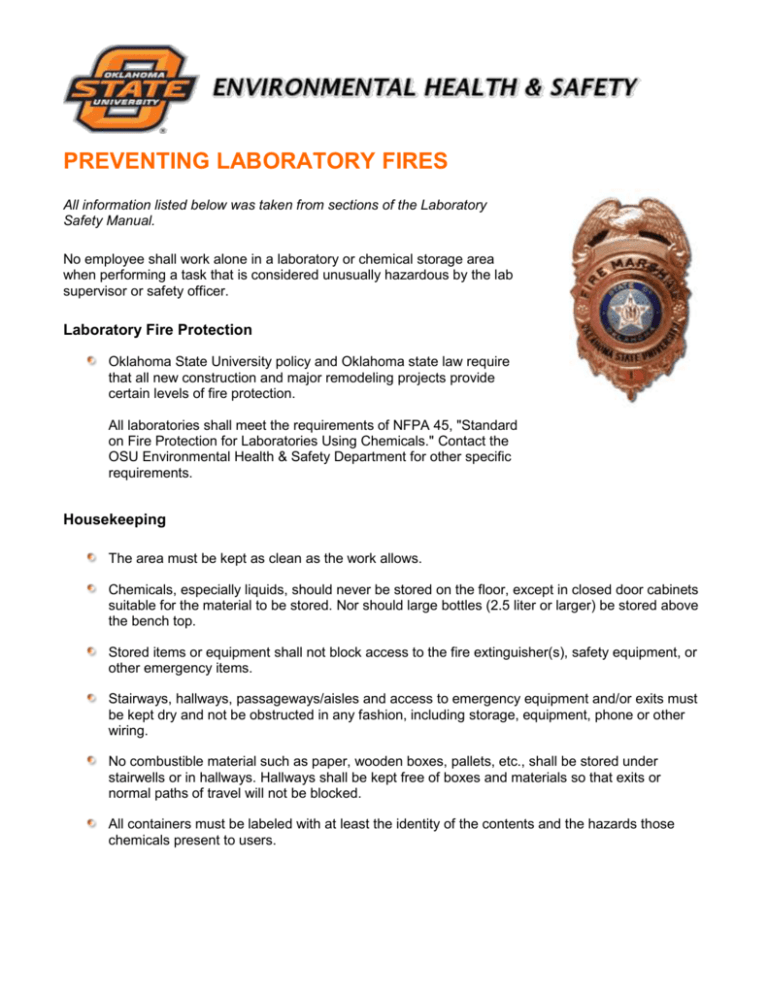
PREVENTING LABORATORY FIRES All information listed below was taken from sections of the Laboratory Safety Manual. No employee shall work alone in a laboratory or chemical storage area when performing a task that is considered unusually hazardous by the lab supervisor or safety officer. Laboratory Fire Protection Oklahoma State University policy and Oklahoma state law require that all new construction and major remodeling projects provide certain levels of fire protection. All laboratories shall meet the requirements of NFPA 45, "Standard on Fire Protection for Laboratories Using Chemicals." Contact the OSU Environmental Health & Safety Department for other specific requirements. Housekeeping The area must be kept as clean as the work allows. Chemicals, especially liquids, should never be stored on the floor, except in closed door cabinets suitable for the material to be stored. Nor should large bottles (2.5 liter or larger) be stored above the bench top. Stored items or equipment shall not block access to the fire extinguisher(s), safety equipment, or other emergency items. Stairways, hallways, passageways/aisles and access to emergency equipment and/or exits must be kept dry and not be obstructed in any fashion, including storage, equipment, phone or other wiring. No combustible material such as paper, wooden boxes, pallets, etc., shall be stored under stairwells or in hallways. Hallways shall be kept free of boxes and materials so that exits or normal paths of travel will not be blocked. All containers must be labeled with at least the identity of the contents and the hazards those chemicals present to users. Oklahoma State University Preventing Laboratory Fires Fire Extinguishers Laboratory personnel should be adequately trained regarding pertinent fire hazards associated with their work. Training of employees in the use of fire extinguishers is required by OSHA 29 CFR 1910.157(g), "...where the employer has provided portable fire extinguishers for employee use in the work place." Such training shall be conducted at initial employment and annually thereafter. Fire extinguishers should never be concealed from general view or blocked from access. Electrical All electrical equipment shall be properly grounded and be U.L. listed and/or F.M. approved. Sufficient room for work must be present in the area of breaker boxes. All the circuit breakers and the fuses shall be labeled to indicate whether they are in the "on" or "off" position, and what appliance or room area is served. Fuses must be properly rated. Equipment, appliance and extension cords shall be in good condition. Extension cords shall not be used as a substitute for permanent wiring. Electrical cords or other lines shall not be suspended unsupported across emergency showers, overhead pipes or frames, metal racks, etc. Do not run cords through holes in walls or ceilings or through doorways or windows. Do not place under carpet, rugs, or heavy objects. Do not place cords on pathways or other areas where repeated abuse can cause deterioration of insulation. Multi-outlet plugs shall not be used unless they have a built-in circuit breaker. This causes overloading on electrical wiring, which will cause damage and possible overheating. Most of the portable multiple outlets are rated at 15 amps. Employees shall check when all connections are made to determine that the total input average will never exceed 15 amps. (The amperage on electrical equipment is usually stamped on the manufacturer's plate.) All building electrical repairs, splices and wiring shall be performed by the Physical Plant Electrical Department. Electrical standards may be obtained by referencing NFPA 70 - NATIONAL ELECTRICAL CODE. Vacuum Operations When a vacuum is supplied by a compressor or vacuum pump to distill volatile solvents, a cold trap should be used to contain solvent vapors. Cold traps should be of sufficient size and low enough temperature to collect all condensable vapors present in a vacuum system. If such a trap is not used, the pump or compression exhaust must be vented to the outside using explosion-proof methods. After completion of an operation in which a cold trap has been used, the system should be vented. This venting is important because volatile substances that have been collected in the trap may vaporize when the coolant has evaporated and cause a pressure buildup that could blow the apparatus apart. After vacuum distillations, the pot residue must be cooled to room temperature before air is admitted to the apparatus. http://ehs.okstate.edu/hazmat/fire-prevention.htm page 2 of 5 Oklahoma State University Preventing Laboratory Fires Explosion-Proof Refrigerators If there is a need to refrigerate a substance that is flammable, it shall be refrigerated in a U.L.listed or F.M.-approved explosion-proof refrigerator. This refrigerator is designed as such that any flammable vapors in the refrigerator do not contact sparks. **This refrigerator must NOT be used for the storage of food.** Ventilation Hoods ONLY ITEMS NECESSARY TO PERFORM THE PRESENT EXPERIMENT SHOULD BE IN THE HOOD. The more equipment in the hood, the greater the air turbulence and the chance for gaseous escape into the lab Exhaust fans should be spark-proof if exhausting flammable vapors and be corrosive resistant if handling corrosive fumes. An emergency plan should be prepared in the event of ventilation failure or other unexpected occurrence such as fire or explosion in the hood. Flammable-Liquid Storage Cabinets Cabinets designed for the storage of flammable liquids should be properly used and maintained. Read and follow the manufacturer's information and also follow these safety practices: 1. Store only compatible materials inside a cabinet. 2. Do not store paper or cardboard or other combustible packaging material in a flammable-liquid cabinet. 3. The manufacturer establishes quantity limits for various sizes of flammable-liquid storage cabinets; do not overload a cabinet. NFPA Guidelines and OSHA Standards on Flammable Liquids are utilized as standards for Worker/Fire Protection at Oklahoma State University. In all laboratory work with flammable liquids, the requirements of 29 CFR (H)-(L), NFPA 30, and NFPA 45 should be consulted and followed. Oklahoma State University Environmental Health & Safety is the local authority having jurisdiction in these matters, and should be contacted for further assistance. Safety Shields Safety shields should be used for protection against possible explosions, implosions or splash hazards. Laboratory equipment should be shielded on all sides so there is no line-of-sight exposure of personnel. Provided its opening is covered by closed doors, the conventional laboratory exhaust hood is a readily available built-in shield. However, a portable shield should also be used when manipulations are performed, particularly with hoods that have vertical-rising doors rather than horizontal-sliding sashes. Portable shields can be used to protect against hazards of limited severity, e.g., small splashes, heat and fires. A portable shield, however, provides no protection at the sides or back of the equipment and many such shields are not sufficiently weighted and may topple toward the worker when there is a blast (permitting exposure to flying objects). A fixed shield that completely surrounds the experimental apparatus can afford protection against minor blast damage. http://ehs.okstate.edu/hazmat/fire-prevention.htm page 3 of 5 Oklahoma State University Preventing Laboratory Fires Compressed Gas Compressed gases may be combustible, explosive, corrosive, poisonous, inert, or a combination of hazards. If the gas is flammable, flash points lower than room temperature compounded by high rates of diffusion (which allow for fast permeation throughout the laboratory) present a danger of fire or explosion. Since the gases are contained in heavy, highly pressurized metal containers, the large amount of potential energy resulting from compression of the gas makes the cylinder a potential rocket or fragmentation bomb. Gas cylinders shall be secured at all times to prevent tipping and be stored in a well-ventilated area. Signs should be conspicuously posted in areas where flammable compressed gases are stored, identifying the substances and appropriate precautions. Cylinders containing flammable gases such as hydrogen or acetylene shall not be stored in close proximity to open flames, areas where electrical sparks are generated, or where other sources of ignition may be present. Cylinders containing acetylene shall never be stored on their side. An open flame shall never be used to detect leaks of flammable gases. Oxygen cylinders, full or empty, shall not be stored in the same vicinity as flammable gases. More information on the safe handling of compressed gas cylinders can be found at http://ehs.okstate.edu/hazmat/labman/Chap2d1.htm Cryogenic Liquids Neither liquid nitrogen nor liquid air should be used to cool a flammable mixture in the presence of air because oxygen can condense from the air and lead to a potentially explosive condition. Adequate ventilation must always be used to prevent the build-up of vapors of flammable gases such as hydrogen, methane, and acetylene. Adequate ventilation is also required when using gases such as nitrogen, helium, or hydrogen. In these cases, oxygen can be condensed out of the atmosphere creating a potential for explosive conditions. Laser Fire & Explosion Hazards High-pressure arc lamps, filament lamps and associated optics can shatter or explode during laser operation. These components must be enclosed in housings that can withstand the maximum explosive pressures. The proper installation of the electrical power supply is also important to reduce the potential for electrical fire. Any enclosures, barriers or baffles must comply with "Polymeric Materials for Use in Electrical Equipment," Underwriters Laboratories Standard, UL 746C. http://ehs.okstate.edu/hazmat/fire-prevention.htm page 4 of 5 Oklahoma State University Preventing Laboratory Fires Safety Audit The safety audit or safety review is an evaluation of a laboratory's total safety program. The purpose of the audit is to rate a safety program, identify its strengths and weaknesses, know where improvements are needed, and obtain commitments and target dates for correcting problems from the managers involved. More information on conducting a safety audit can be found at http://ehs.okstate.edu/hazmat/labman/Chap7b1.htm#SafetyAudits Example of an audit checklist: http://ehs.okstate.edu/hazmat/labman/Appendix-L.htm Laboratory Fire Procedures: http://ehs.okstate.edu/hazmat/Fire-in-Lab.htm http://ehs.okstate.edu/hazmat/fire-prevention.htm page 5 of 5
